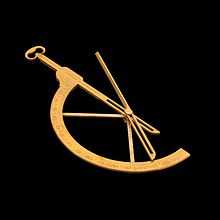Goniometer


A goniometer is an instrument that either measures an angle or allows an object to be rotated to a precise angular position. The term goniometry is derived from two Greek words, gōnia, meaning angle, and metron, meaning measure.
Applications
Communications
Goniometers are used for direction finding in signals intelligence applications for military and civil purposes,[1] e.g. interception of satellite and naval communications as performed on the French warship Dupuy de Lôme uses multiple goniometers.
Crystallography
In crystallography, goniometers are used for measuring angles between crystal faces. They are also used in X-ray diffraction to rotate the samples. The groundbreaking investigations of physicist Max von Laue and cohorts into the atomic structure of crystals in 1912 involved a goniometer.
Light measurement
Goniophotometers measure the spatial distribution of light visible to the human eye at a specific angular position.
In Medicine
Medical practitioners, (physicians, physician assistants, physical therapists, athletic trainers, chiropractors and Nurse Practitioners) use a goniometer to document initial and subsequent range of motion, at the visits for occupational injuries, and by disability evaporators to determine a permanent disability. This is to evaluate progress, and also for medico-legal purposes. It is a tool to evaluate Waddell's signs (findings that may indicate symptom magnification.)
Physical therapy
In physical therapy and occupational therapy, a goniometer is an instrument which measures an axis and range of motion. If a patient or client experiences decreased range of motion in a joint (e.g. a knee or elbow), the therapist can use a goniometer to assess the range of motion before intervention, and then make sure it is working by using the goniometer in subsequent interventions.
Surface science

In surface science, an instrument generally called a contact angle goniometer is used to measure the static contact angle, advancing & receding contact angles, and surface tension. The first contact angle goniometer was designed by Dr. William Zisman of the United States Naval Research Laboratory in Washington, D.C. and manufactured by ramé-hart (now ramé-hart instrument company), New Jersey, USA. The original manual contact angle goniometer used an eyepiece with microscope. The current generation of contact angle instruments uses cameras and software to capture and analyze the drop shape and are better suited for dynamic and advanced studies. A centrifugal Adhesion Balance is used to relate the contact angles to the adhesion of the drop to the surface. A gonioreflectometer is used to measure the reflectivity of a surface at a variety of angles.
The use of the term "contact angle goniometer" in connection with photographic or video capture systems focused on sessile drops is often a misuse of the word goniometer, as most systems do not measure angles. Images are captured and operator imposed asymptotes are drawn, and the software connected with the drawing actions then computes the angle between these operator imposed lines, the contact angle.
Surface tension

Contact angle goniometers (q.v.)can also determine the surface tension for any liquid in gas or the interfacial tension between any two liquids. If the difference in densities between the two fluids is known, the surface tension or interfacial tension can be calculated by using the pendant drop method.
Positioning

A positioning goniometer or goniometric stage is a device used to rotate an object precisely about a fixed axis in space. It is similar to a linear stage, however, rather than moving linearly with respect to its base, the stage platform rotates partially about a fixed axis above the mounting surface of the platform. Positioning goniometers typically use a worm drive with a partial worm wheel fixed to the underside of the stage platform meshing with a worm in the base. The worm may be rotated manually or by a motor as in automated positioning systems.
Knife and blade cutting edge angle measurement
The included cutting angles of all kinds of sharp edge blades is measured using a laser reflecting goniometer. Developed by CATRA in the UK, a range of devices can accurately determine the cutting edge profile including a rounding of the tip to ½°. The included angle of a blade is important in controlling its cutting ability and edge strength, i.e. a low angle makes the edge thin and optimized for cutting while a large angle makes it thick, which cuts poorly, but is very strong.
Doctor blade inspection
Used doctor blades, from gravure and other printing and coating processes, may be inspected using a goniometer, typically with a built-in light source, to examine the blade edge to see whether the blade has worn at the desired angle and whether there are signs of wear at other angles. A difference in angle from that set on the machine may indicate excessive pressure, and a range of angles ("rounding") probably indicates a lack of stiffness, or wear, in the blade holder assembly.
See also
| Wikisource has the text of the 1911 Encyclopædia Britannica article Goniometer. |
References
- ↑ Jacqueline Boucher (2007-05-03). "Radio receiver workload accelerates". Retrieved 2007-09-21.